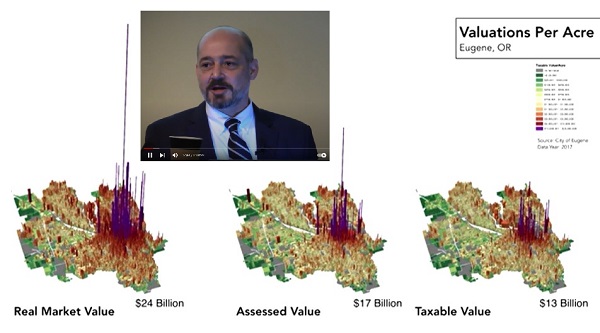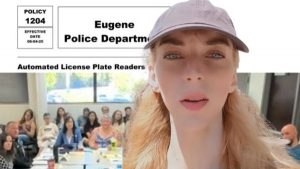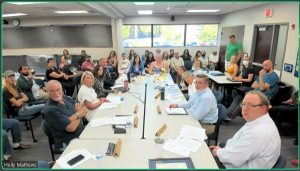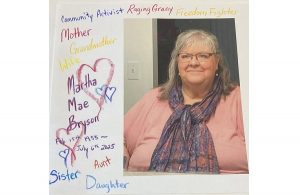Todd Boyle, John Barofsky offer comments on urban renewal funding
9 min read
The Eugene City Council heard public comment June 26 about urban renewal funding.
[00:00:07] Todd Boyle (June 26, 2023): With great trepidation, I am against the approval of the $37 million appropriation for the urban renewal program. And a basic premise of urban renewal is that the urban renewal district is blighted.
[00:00:23] Downtown Eugene is not blighted. The Riverbank’s not blighted. The downtown is thriving. As evidence, I would offer the spike map provided by Joe Minicozzi in his 2019 report to the city. This is a map that shows green spikes where the revenue is positive and it shows massively positive property tax revenue in the downtown and the near west side.
[00:00:44] John Q: Here’s a summary of that report to the city from May 2019.
[00:00:50] Joe Minicozzi (at the Downtown Athletic Club, May 16, 2019): Every community I go to, people have their biases about what cities are and they don’t understand them at an economic or architectural level.
[00:00:57] When we talk to farmers, they’re always talking in economic models: crop yield per acre, water per acre, all that stuff. Do the same with the city. If you look at the land like a farmer looks at land and see the buildings as crops, you can see your city a little bit differently.
[00:01:09] So here’s ground story retail, second floor office, upper story residential. This is a streetscape project that the city did. So thank you city for the garbage can, the bike rack, two benches, and the street tree.
[00:01:20] That’s a subsidy in front of that building, right? Fair enough. But the taxes on this property went from $300,000 tax value to $11 million. So the taxes shot up 3500%. That’s the investment my community gets. That’s the taxes y’all get. Go out and buy 3,500% more garbage cans, whatever, we don’t care. This is building your community’s wealth.
[00:01:42] Lots of times people say to us, ‘Joe, if you’re just going about money, you just want skyscrapers everywhere. You just want tall buildings.’ It’s like, ‘No, that’s not the point. I need you to see information and think critically about what you’re doing.’
[00:01:54] So these are two buildings two blocks away from each other in West Palm Beach. This three-story building (one, two, three) is worth $10.5 million an acre. Two blocks away is a skyscraper worth $9.2 million an acre. So from a productivity standpoint, that three-story building is more productive than this (skyscraper).
[00:02:12] Design and value and density are all part of the quotient. Get into the numbers. Don’t be afraid of this stuff. See what’s going on.
[00:02:19] Your county’s about 60% non-taxable. It is what it is. Your city urban growth boundary is about 24% non-taxable; when you get into just what you can control it’s about 27% non-taxable. This is about average for what we see for cities particularly that have a large university.
[00:02:34] The average building is pulling about $66 a square foot of value. Parking is only about $9 a square foot. The road that you all have to pay for is pulling about $24 a square foot.
[00:02:44] They ran the numbers in 2017, so your city has this awesome document with the real market value, the assessed value, and the taxable value, right? The only thing we really care about is here’s your total taxable value, here’s your value per acre.
[00:02:57] You have some fun measures. You put them in place. You’re not alone in this. California Prop 13 spread like wildfire across the country. We’re a country of tax evaders, folks. We started a revolution over a tax. We don’t like paying taxes. So people adopt these measures.
[00:03:18] What happens when the market takes off in real world? Price of lumber, what happens? Goes up. Price of gasoline, price of labor, price of concrete. So when you have this happen, all of a sudden you can’t afford your city anymore. Because if your city has to go out and pay for concrete or asphalt or a tree, it’s going to pay market prices, but your revenue is constricted.
[00:03:40] This is just what y’all have done to yourself. There’s an $11 billion difference between your value where it should be and where it’s being capped for your cash flow for your councilors. So your councilors have a limited budget to play with, for all the things that you want to build as a community.
[00:03:55] When you look at your bills, your roads and pipes are your expensive stuff.
[00:03:59] You have enough roads to go from Eugene to San Francisco. Did y’all know that? You have about 900 square feet of building per person in Eugene, about 450 square feet of parking per person. So every single person in here has 1.3 parking spaces dedicated to yourselves, across the city. That’s a lot of asphalt.
[00:04:17] Y’all are taking out bonds to pay for your roads. And you actually have a very, very prudent bond program to do this stuff. But your taxes still have to pay off that bond payment. And the thing that’s scary about roads, it should be a little sign to you that when you have to bond out to pay for infrastructure, you’re going to have to bond out to pay for fixing it again.
[00:04:35] That means that you can’t currently afford it inside your general fund. You essentially can afford about 70% of your roads.
[00:04:41] So this is a question you should ask yourself: Nine percent of your system is essentially privatized, but y’all are picking up that tab; 9% of your system are in these ‘danglers.’ That’s not a network, that’s a driveway. So the public is funding these seven people to have a driveway right there. Why is that a road?
[00:05:00] Is that what you all decided to pay for? Is this that high on your priority of social problems for your community, to give people a driveway? Where’s homelessness? Have a conversation about that.
[00:05:11] When you build a road, it has to be rebuilt every 40 years. You also have a second rebuild cycle you’re living through, and you’re about to walk into a third rebuild cycle. Roads in 1939 got rebuilt in ’79, and you’re rebuilding those.
[00:05:24] If you’re already taking out loans to pay for this stuff, you’re going to have to keep doing that.
[00:05:28] So let me ask you a question: Do you all remember the public meeting that you all had where you said, ‘We’re going to subsidize parking and we’re going to put that into the system’?
[00:05:34] Think about how to cultivate your wealth so you can pay for the things you need to support your community: Affordable housing, artist programs, drug counseling, homeless shelters.
[00:05:43] Think about your diet of land use and how to balance it. You’re going to have controversial discussions, you’re going to have to have compromises, but you have to find a way to balance that land use. You have to deal with this. This is your data.
[00:05:56] John Q: With that background, here again is the June 26, 2023 public comment from Todd Boyle.
[00:06:02] Todd Boyle (June 26, 2023): …The downtown is thriving. As evidence, I would offer the spike map provided by Joe Minicozzi in his 2019 report to the city. This is a map that shows green spikes where the revenue is positive and it shows massively positive property tax revenue in the downtown and the near west side.
[00:06:20] Another evidence is the report of Denny Braud to the City Club, also in 2019, displaying many dozens of new and renovated buildings downtown.
[00:06:29] So, in my view, the city should declare victory and begin phasing out this program for urban renewal of the downtown and riverbank developments. The program is an anachronism from previous generations.
[00:06:42] So, anyway, I would recommend the program be phased out in an orderly manner, completing all of its existing commitments and plans, but no further. In other words, you would only be approving the appropriations required for the existing commitments.
[00:06:54] And really, the blight that is affecting our city is of human character. And like urban blight, it’s the result of underinvestment in the social capital, the actual needs of our human population. There are thousands of citizens who are in crisis and need. We are taking care of many thousands of people. This is good. But we have many difficult cases that require millions of dollars of staffing for mental health services, addiction recovery services, and facilities, and case workers.
[00:07:22] Of course, all citizens have to be assured some sort of shelter or housing. It’s very shortsighted having police agencies confront them every day on the streets, telling them that they are not welcome and that they have to move, confiscating their belongings and so forth. This perpetuates a cycle of stress and alienation.
[00:07:38] People need to remember that the urban renewal program is a direct carveout from the general fund. And we already have an $8.3 million budget shortfall, even with inadequate funding of human services.
[00:07:51] At every city council meeting, people are asking for solutions to housing, homelessness, and public safety. Literally, no one is asking you to spend this $37 million on new building.
[00:08:02] Cherish Bradshaw (City of Eugene): Next we’ll hear from John Barofsky.
[00:08:04] John Barofsky: …At your June 12 work session, there were some tables in your packet on the projected revenue and expenditures.
[00:08:13] So, housing development fees was $8.3 million over the lifespan of this $50 million that you guys approved. Housing land acquisition was $8.3 million, physical improvements $6.7 million, emerging projects $10 million.
[00:08:31] The line that gives me pause is ‘Project Delivery and Administration, $16.3 million.’ One-third of the $50 million is being set aside for project delivery and administration. To me, that’s equivalent to what has been happening with the money that’s going to the Planning and Development (Department).
[00:08:55] I understand that it takes a lot of money and a lot of staff time to implement these large projects that the city is looking for. But this is almost $800,000 every year until FY43.
[00:09:12] I hope that in the future, we can keep an eye on that and make sure that we are doing our best to rein in the costs of project delivery and administration, especially if a lot of this is front-loaded and we put a lot of the projects early on in the queue. There’s $900,000 going for project delivery in FY43, when there’s only $99,000 being spent.
[00:09:40] So just, you guys keep your eyes on this because one-third of the money going to delivery is a lot.
[00:09:50] Councilor Mike Clark: Looking at the administrative costs, $16 million, that kind of shook me a little when I saw it too, and I would just say that I know that in years past, a lot of those folks who have had a problem with the idea of urban renewal, one of their major complaints about it was what they would call and have called a slush fund for the city or for the planning department.
[00:10:18] And I don’t look at it that way, but I think it’s wise for us to consider that that’s a major objection of theirs to the program. And we may want to reconsider how we spend that allocated and planned $50 million.
[00:10:35] City Manager Sarah Medary: Yeah, I was just going to make a comment about the project delivery administrative costs because what we did in this plan is pretty consistent with others, which is you include a bucket of what is eligible. So this is sort of the eligible expenses.
[00:10:51] And just a reminder, this is some city staff costs, but it’s also legal costs, design costs, anything it takes for us to deliver a project and this is going to be a pretty unique one as we try to develop a lot of housing in the downtown.
[00:11:03] So that’s an eligibility, it doesn’t mean all those dollars need to be spent and we can certainly keep track year over year over year of what’s actually being spent out of there. That’ll be part of our reporting and something we keep track of and, it matters to me too, because as you know, with our current situation, there are no slush funds.
[00:11:21] John Q: Todd Boyle remembers Joe Minicozzi’s spike map from 2019 and says downtown isn’t blighted. John Barofsky points out that about a third of urban renewal funds would go for ‘Project Delivery and Administration.’



